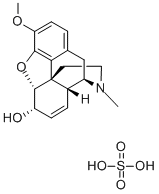1420-53-7

SAFETY INFORMATION
| Signal word | Warning |
|---|---|
| Pictogram(s) |
 Exclamation Mark Irritant GHS07 |
| GHS Hazard Statements |
H302:Acute toxicity,oral |
COMPUTED DESCRIPTORS
| Molecular Weight | 696.8 g/mol |
|---|---|
| Hydrogen Bond Donor Count | 4 |
| Hydrogen Bond Acceptor Count | 12 |
| Rotatable Bond Count | 2 |
| Exact Mass | 696.27166678 g/mol |
| Monoisotopic Mass | 696.27166678 g/mol |
| Topological Polar Surface Area | 167 Ų |
| Heavy Atom Count | 49 |
| Formal Charge | 0 |
| Complexity | 590 |
| Isotope Atom Count | 0 |
| Defined Atom Stereocenter Count | 10 |
| Undefined Atom Stereocenter Count | 0 |
| Defined Bond Stereocenter Count | 0 |
| Undefined Bond Stereocenter Count | 0 |
| Covalently-Bonded Unit Count | 3 |
| Compound Is Canonicalized | Yes |
PRODUCT INTRODUCTION
description
Codeine Sulfate is the sulfate salt form of codeine, a naturally occurring phenanthrene alkaloid and opioid agonist with analgesic, antidiarrheal and antitussive activity. Codeine sulfate mimics the actions of opioids by binding to the opioid receptors at many sites within the central nervous system (CNS). Stimulation of the mu-subtype opioid receptor stimulates the exchange of GTP for GDP on the G-protein complex and subsequently inhibits adenylate cyclase. This results in a decrease in intracellular cAMP and leads to a reduction in the release of neurotransmitters such as substance P, GABA, dopamine, acetylcholine and noradrenaline. The analgesic effect of codeine sulfate is likely due to its metabolite morphine, which induces opening of G-protein-coupled inwardly rectifying potassium (GIRK) channels and blocks the opening of N-type voltage-gated calcium channels, thereby resulting in hyperpolarization and reduced neuronal excitability.
